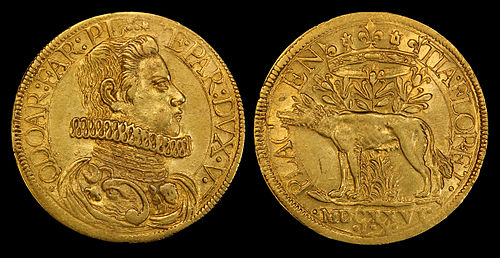Talk:Doubloon
| This article is rated Start-class on Wikipedia's content assessment scale. It is of interest to the following WikiProjects: | ||||||||||||||||||||||||||
| ||||||||||||||||||||||||||
This should not be moved to Wiktionary. Any type of coin should be a topic for a dictionary article. Burschik 10:44, 11 Mar 2005 (UTC)
I would like to see an image of a doubloon and a Mardi Gras doubloon using {{Infobox Coin}}. --JAYMEDINC 02:31, 26 November 2006 (UTC)
I understand the dubloon also referred to an 8 escudo coin, divided in equal parts, hence the pirate movie phrase... Trekphiler 09:40, 29 December 2006 (UTC)
Yes, I too thought that a doubloon was 8 escudos, not 2. Can anyone find an authoritative source for this? —Preceding unsigned comment added by 220.255.7.172 (talk) 06:41, 23 August 2008 (UTC)
There is (at least now) a very good piece of eight] article that answers this. 71.165.114.156 (talk) 23:24, 18 October 2009 (UTC)
- And why do you think it's called a DOUBLoon? it's because it's a double escudo. The 8 thing, as mentioned above is for the 8 real piece of eight, a quarter of the original doubloon. --Svartalf (talk) 06:08, 4 May 2013 (UTC)
Popular Culture
[edit]I'm for deleting most of the Popular Culture entries, keeping only Mardi Gras, Moby-Dick and Raymond Chandler. Opinions? —Tamfang (talk) 22:19, 5 August 2012 (UTC)
- I came here to ask about popular culture references. The board game Jamaica uses doubloons.[1] That said, it's kind of like something using "pieces of eight" or dollars. So I'm all for keeping most pop culture out. - Paul2520 (talk) 01:55, 6 February 2016 (UTC)
8 escudo?
[edit]Wait a minute... the doubloon was originally a 6.some gram 2 escudo coin, hence the word Doblon... what's this story about it being a 27.some g, 8 escudo coin? I'm seriously tempted to revert the last two edits to revert to a serious article... --Svartalf (talk) 10:10, 17 April 2015 (UTC)
Addressed by citing the "confusing English colonial nomenclature" under "History". The doubloon is properly $4, but for English colonials the $16 coin was both called the "double doubloon" and the "Spanish doubloon". So go figure... Oppa gangnam psy (talk) 21:40, 10 June 2021 (UTC)
File:Italian States-Piacenza 1626 2 Doppie.jpg scheduled for POTD
[edit]Hello! This is to let editors know that the featured picture File:Italian States-Piacenza 1626 2 Doppie.jpg, which is used in this article, has been selected as the English Wikipedia's picture of the day (POTD) for February 11, 2021. A preview of the POTD is displayed below and can be edited at Template:POTD/2021-02-11. For the greater benefit of readers, any potential improvements or maintenance that could benefit the quality of this article should be done before its scheduled appearance on the Main Page. If you have any concerns, please place a message at Wikipedia talk:Picture of the day. Thank you! Cwmhiraeth (talk) 11:35, 24 January 2021 (UTC)

|
|
The doubloon was a Spanish gold coin worth two escudos or 32 reales weighing 6.867 grams (0.221 troy ounces), introduced in 1537. It became the model for several other gold coins issued in Europe, including this 1626 two-doppie gold coin issued in Piacenza in northern Italy by the Duchy of Parma, depicting Odoardo Farnese, Duke of Parma, on the obverse. The coin is part of the National Numismatic Collection at the National Museum of American History. Coin design credit: Duchy of Parma
Recently featured:
|


